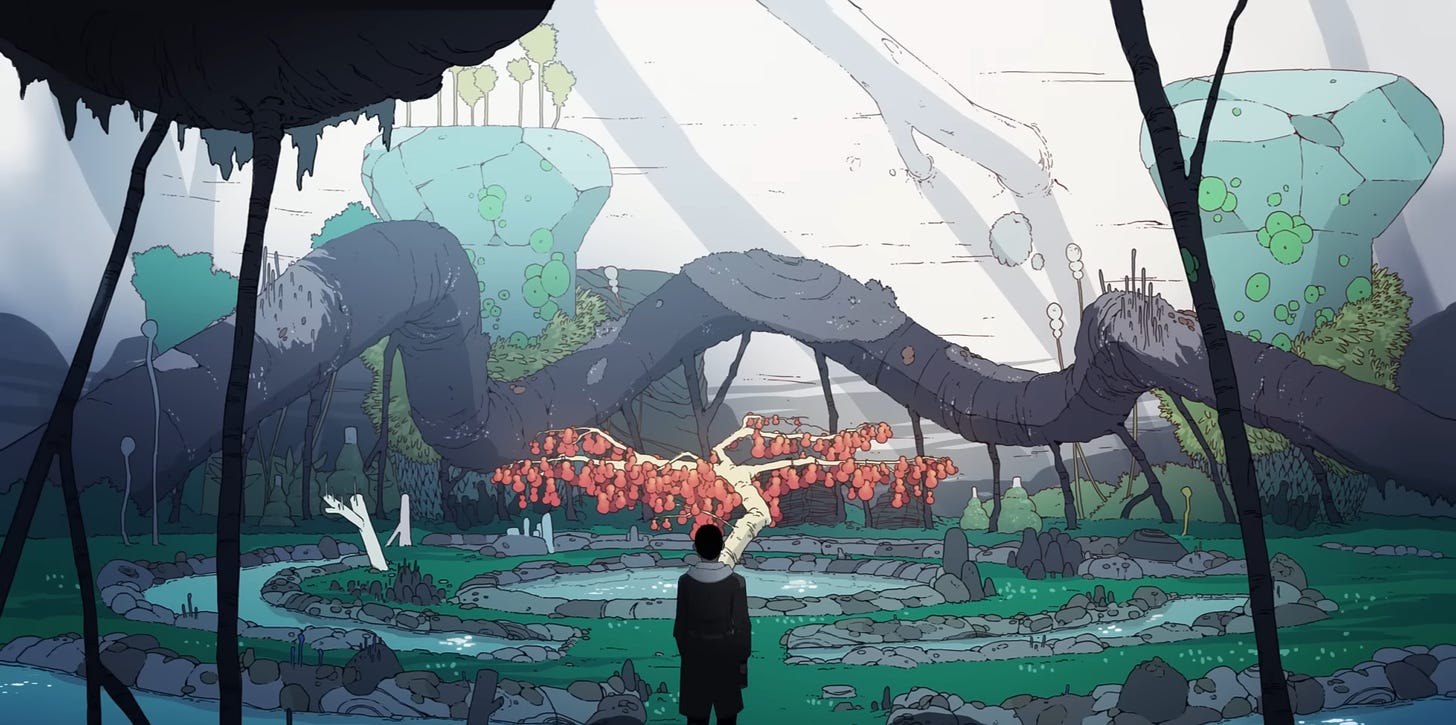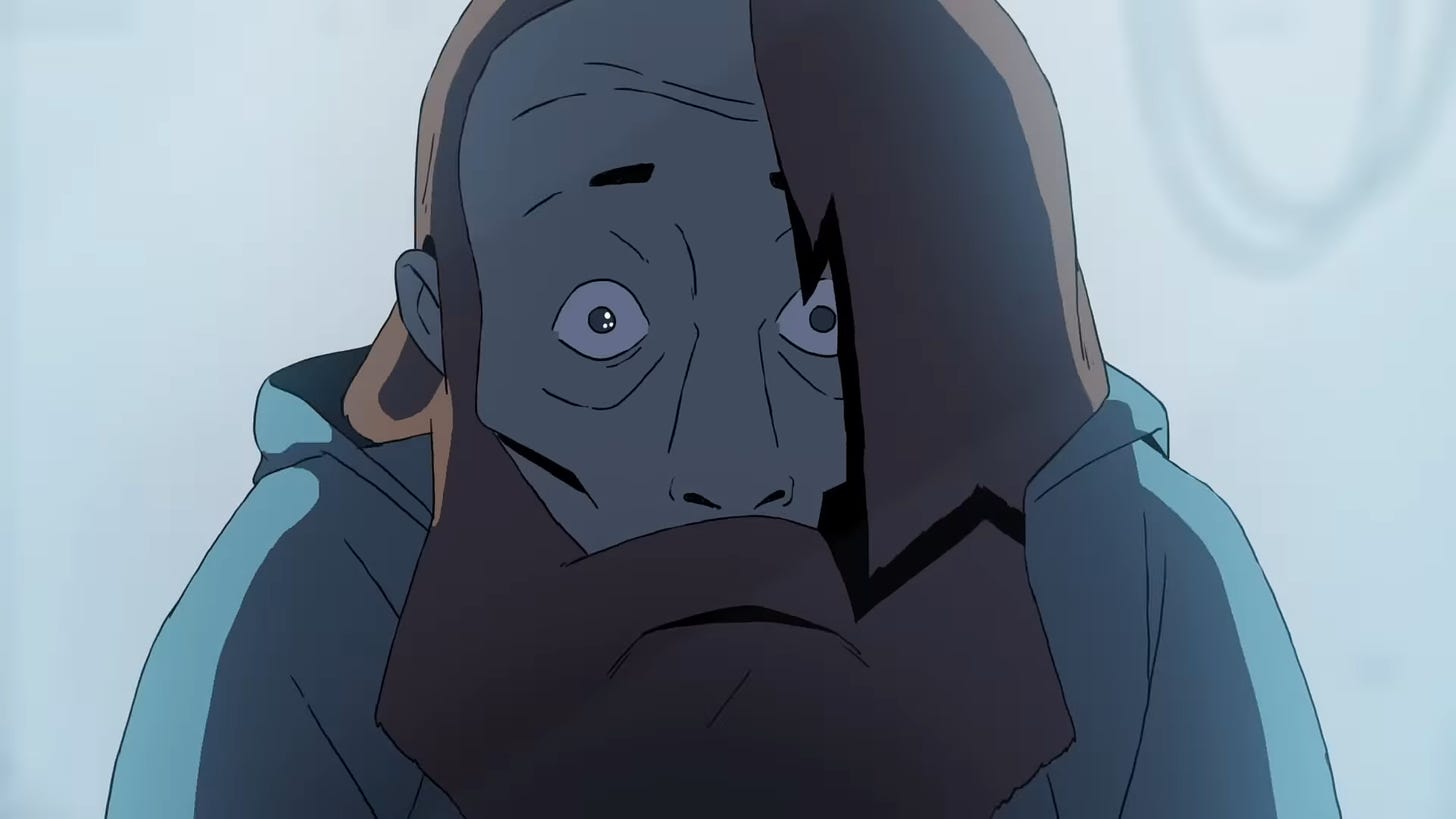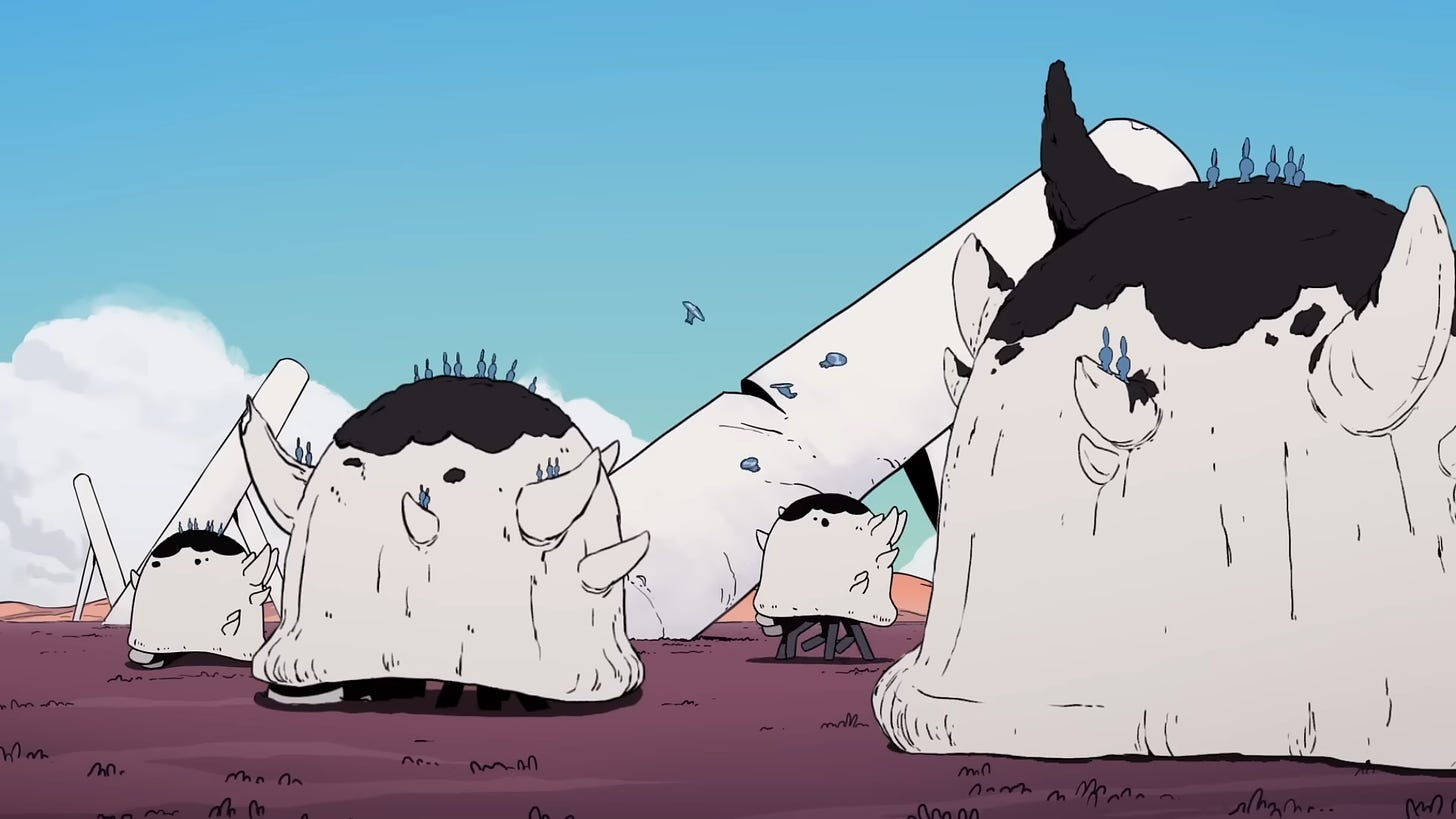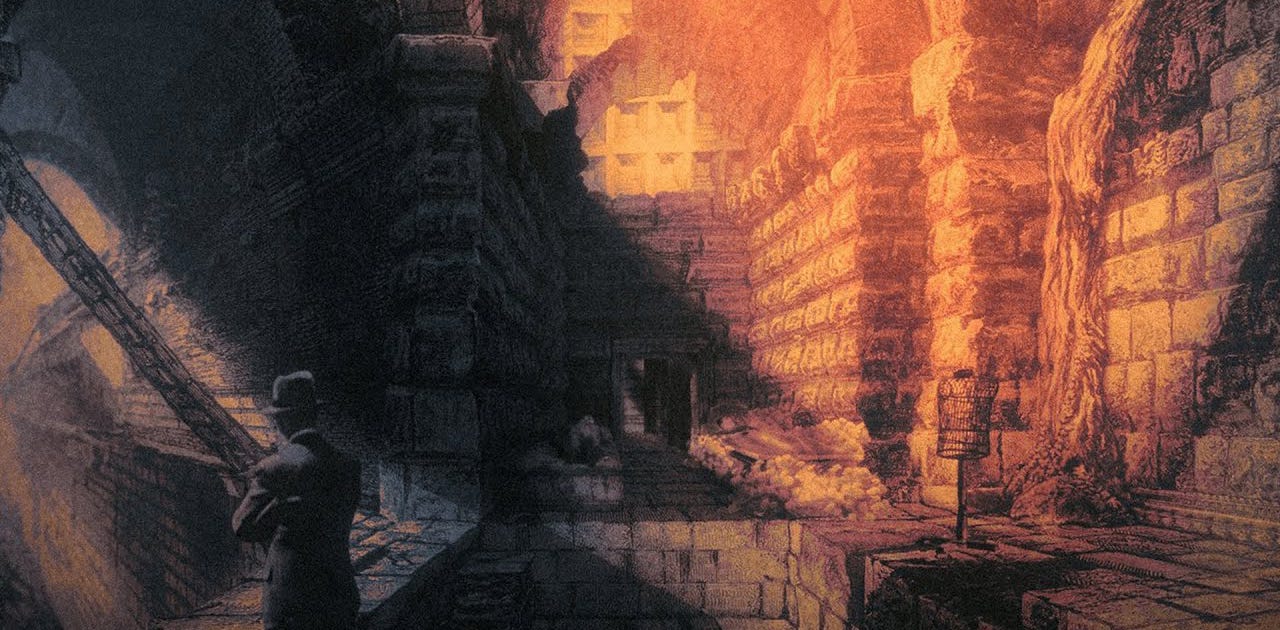Welcome back! We’re here with another Sunday issue of the Animation Obsessive newsletter — we hope you’ll enjoy it. Here’s our slate today:
1️⃣ A look inside Scavengers Reign.
2️⃣ The animation news of the world.
If you’re just finding us — it’s free to sign up for the newsletter. You’ll get our Sunday issues right in your inbox, weekly:
With that, we’re off!
1: “Exactly what we wanted to make”
California is the seat of American animation — and its industry is in turmoil.
Priorities have changed in Hollywood. Insiders talk constantly about how scarce animation jobs have gotten. That’s reflected in the headlines — another round of cuts at Netflix Animation this week, 70 jobs gone at DreamWorks Animation earlier this month (and likely more soon). The trend has run through 2023 and even 2022.
The signs point in one direction: Hollywood’s animation boom is over. For the jobs that do remain, the threat of automation is real. As Cartoon Brew reported in August, “Tech Bros Want to Replace Storyboard Artists with Artificial Intelligence.” A Hollywood producer recently said that “a lot of people are using [AI] in development.”
Even in the crisis, though, fresh and exciting animation emerges from California. Scavengers Reign is a big one this year. You may have seen its new trailer or the rave reviews. The series hits Max on October 19, and it’s one to take seriously.
Scavengers Reign is a sci-fi drama for adults that looks like a Moebius comic in motion. If you’ve watched the trippy Adult Swim short Scavengers (2016), this is the same team and same basic idea, only bigger. It’s about surviving on an alien world — and it defies every single preconceived idea about American adult animation.
Titmouse produced the series, but it was dreamed up at the new-ish Green Street Pictures in Los Angeles. We were surprised to see one particular writer and executive producer in the credits: Sean Buckelew, whose viral indie short Drone we covered (and really liked) earlier this year. So, we set up an interview to learn more about Scavengers Reign.
Sean spoke to our teammate Jules about the series’ background, the challenge of doing something so weird in Hollywood, Green Street’s efforts to hire talent from the French animation scene and how making Scavengers Reign was like “making an independent short with your friends.”
Their conversation, edited for length and clarity, appears below.
Jules: How would you describe Scavengers Reign?
Sean Buckelew: I would say it’s a story about a group of space travelers who get marooned on an alien planet, and then have to adapt and survive in this strange, alien landscape, ecology and environment.
What is the series like, exactly? Tonally, and its influences?
On some level, it’s a survivalist science fiction/fantasy action story.
But what really got us excited in making it was more, “Oh, it’s like Werner Herzog on an alien planet.” It gets into existential themes about your humanity in a context that’s really crazy, and what you do to survive. Mixed with trying to make it like a documentary about an alien planet. There’s a lot about the process of the environment, how cycles of nature function in this bizarro fantasy ecology. Somewhere between those two things.
With its influences, there are obvious ones like Nausicaä and Akira, anime stuff. We talked about that William Friedkin movie Sorcerer (1977) and the slow-paced process, the traveling. And then 28 Days Later. Last of the Mohicans for tone and trying to build these big, dramatic moments.
It’s an adult animated show, but it’s trying to avoid… I feel like there’s more character drama and less fight choreography. It’s more about people struggling to find meaning in this context of being stranded on this alien planet.
As an adult animated drama in the US, has it faced many unusual difficulties in getting made?
To me, it was more getting it off the ground. There was originally a short that Joe [Bennett] and Charles [Huettner] made for Adult Swim — it premiered back in 2015 or 2016. It had an interesting life because it so clearly demonstrated how this could work, even though the short itself is probably more experimental than a thing that would typically make you think, “This is definitely going to be a TV show.”
But it showed how visceral this type of idea could be. So, for us, it was a matter of demonstrating at each stage, “I know this feels like it’ll be a tough sell, but actually it’s very fun and very interesting and very watchable.”
Once it was actually happening as a series with Max, they really understood what we were trying to do and were such champions of it. It felt like we had very good partners and got to make exactly what we wanted to make. That part felt very lucky. I think we all experienced it as an extreme privilege to be in a position to make the show we wanted to make, even though it’s a pretty strange show [laughs].
Does it have that same far-out, sort of experiential animation that the original short did?
Yeah. We’ve been working on it like… we all came up making stuff through remote collaborations with friends on the internet. That’s how we came together on the original Scavengers short — it was people from all over. Lots of people from France, and the creativity and talent over there. When it became the show, it pulled everyone together, this huge crew.
It’s got some very good animation. It really relies on visuals for a lot of moments — there are huge setpieces with no dialogue; it’s all kind of bespoke animation. The short now, to me, feels sort of primitive compared to how sophisticated it got later on.
Could you talk about the operations of Green Street Pictures? How the company’s organized and how it finds partners?
It was founded in the pandemic — Joe Bennett, James Merrill, Benjy Brooke and I are the four founding partners, and each one of us played a different role. James and I were both co-executive producers on Scavengers, and writers. Then Joe, obviously, is the co-creator, and Benjy was the supervising director.
It was born out of the fact that we all made work in a similar way, and we were all responding to the same work that was coming out around the world. With the stuff we really loved, we felt like those people were siloed away from LA TV animation. Our feeling was, “There are all these people we’re friends with who, if given a shot in this world, would really thrive and create the kind of work that everyone says they want to see.” It was a simple premise.
With Scavengers, we were making it, obviously, with Titmouse, but we got latitude to build the pipeline and create a team Green Street-style. It’s a little atypical for TV animation. We were standing on the shoulders of shows like Primal and Castlevania that paved the way for getting this really insane, bespoke animation and integrating it into a TV pipeline.
I have a basic belief that there’s so much crazy talent out there. Now that geography is less important, creating a central entity that can pull those people in and figure out pipelines that work with how they want to work, integrated into TV and features, was how we thought about Green Street.
Could you offer a few more details about hiring international artists to work on Scavengers?
We’ve been big fans of the 2D animation scene in France, which we’d mainly experienced through Instagram. We wanted to bring as many of these artists on board as we could. A great example — we saw this incredible student film from Gobelins called Louise [2021, explicit], so we reached out and got a couple of the directors from that short to work on the show.
Another example is our friend Vincent Tsui, who is a mega-talented animator-director we’ve been collaborating with for a long time, and who directed three episodes of the show. But he also happens to not live in the US anymore.
I think this kind of collaboration was possible before the pandemic, but it’s become more acceptable and the technology to facilitate it has definitely improved in the past couple of years.
The French indie animator Jonathan Djob Nkondo is a returning artist from the original short, and he took important roles on the series. What were his contributions like?
Jonathan did so much on this show. When Joe and Charles were initially developing the pilot, they asked Jonathan to do character designs for the main cast. He was also a board artist and animator on the pilot. Then, once the series started, he was a no-brainer choice to direct. He’s so talented. We were incredibly lucky to get his creative DNA into the show.
What’s been your own experience acting as an executive producer?
I mean, it was interesting. It was my first time doing it. There’s a little bit of “you don’t know what you don’t know,” which can be a blessing and a curse. It was certainly a learning experience. But it was great because I got to get a bird’s-eye view on everything.
Then again, for me, it was sort of exactly how I’m used to working. We’re in edits and it’s a group of friends, who’ve all worked together before, talking about how to make it better. You’re wearing a bunch of different hats. Like, “Oh, I could write this. I could do a little thumbnail board for this. I could do a little bit of animation. This is messed up, so let’s put our heads together top-to-bottom and come up with solutions.”
Joe and I have worked together in the past, and it’s essentially the same process. It’s more that it’s very stressful and the volume of everything is way higher — in a good way. Our partners producing it at Titmouse held our hand a lot on the stuff we didn’t know. They were fantastic. But, creatively, it wasn’t too dissimilar from making an independent short with your friends, in terms of how the conversations actually felt.
Lastly, do you hope that the series could be a sign of things to come for streaming and TV?
I hope so. You know, we put so much heart and passion and excitement into it that you hope it’s reciprocated, and that it’s seen as a worthwhile endeavor. But we’re so tunnel-vision about the show that it’s just a matter of hoping people enjoy it or connect with it.
It’s an interesting question because, for us, animation craft stuff is something we talk about a lot. And I don’t know how broad that is. People might not respond to that, or be able to articulate why they enjoy a certain thing. But the hope is, because this is a type of animation and a style of show you don’t typically see, that will have an [effect].
People might not be able to say, “They did this rough animation ‘on twos’ and it’s so smooth.” They’ll say, “Oh, I just like it.”
Our thanks to Sean for sparing time to chat. As mentioned above, Scavengers Reign is set to premiere on October 19.
2: Animation news worldwide
The banning of a Russian film
Before the war, Russian animation was blooming. There was money and support for artful, personal work — and the commercial industry was showing solid growth.
Even now, there are positive signs on the surface. A study just revealed that the average animator salary in Russia is up 42% since last year. There’s more state support for the arts, too. Yet that support increasingly favors propaganda — Film Distributor’s Newsletter noted this week that there’s “more and more ideologically correct cinema.” And the rise in salaries is tied to a rise in job vacancies: artists have left Russia in droves.
Then you have the aggressive censorship. Last month, the government banned the live-action Ayta, a popular Yakut feature, on political grounds. This month, the target is animated.
The film is Fairytale (2022), an experimental collage work by Alexander Sokurov. He’s a senior director from the Soviet days who remains a loud, contentious voice in Russian society. Earlier this year, he accused Putin’s government of suppressing art and culture at a scale unseen even in the USSR. Now, after a successful festival run abroad, Fairytale has been denied a distribution certificate in Russia.
As Sokurov wrote on Telegram this week:
Big problems lie ahead in life — as in Soviet times, when all my work was banned from being shown. [...] I don’t ask for help: as before, no one can help me. Obviously, there is a refusal to issue a distribution certificate for Fairytale — a censorship ban on showing the film in my homeland. And an unspoken ban on showing all of my cinematic works created previously.
Fairytale is a dreamlike, experimental piece about Stalin, Hitler, Mussolini and Churchill in purgatory. It’s a critique of power. Around a month after Russia invaded Ukraine, Sokurov said that his film was “very important for our time.”
Discussing the ban on Fairytale, the paper Vedomosti noted that it’s only the latest instance of an anti-Stalin film being suppressed by the current government. At the Gulag History Museum in Moscow, screenings of the features Captain Volkonogov Escaped and Here’s to You and Us! were canceled back in August.
Newsbits
An American animation story flying under the radar: archivist Jon Whitehead has salvaged and published a bunch of ‘80s and ‘90s CalArts student films — some previously believed to be lost.
Hayao Miyazaki’s The Boy and the Heron has become a hit in Taiwan. It topped the box office charts and broke Ghibli’s opening-week record in the country.
Three Ukrainian animators who work in North America discussed their careers. One of them, Nataliia Alekseieva of LA, says that her salary is much higher than in Ukraine. “But my standard of living here is about the same as it was when I worked as an animator in my homeland,” she said. “The salary seems great, but the groceries and rent are so much more expensive that it comes out the same.”
In China, artists are being recruited to work on the sequel to Nezha — the most successful Chinese animated film to date.
Hiring freelancers from across the globe has been the trend in Japanese animation for several years. Animenomics interviewed Jarrett Martin about this new reality — and the role that his company Tonari Animation plays in it.
Mexican animator Rita Basulto (Pinocchio) spoke to Animation Magazine about her stop-motion film Humo: “it took me six years to complete this short,” she says.
Also in Mexico, director Karla Velázquez is developing a stylish feature called Kolaval, about an indigenous warrior. She talked to Radix about the project.
There are new Indian animated ads by Vaibhav Studios (for Vodafone Idea) and Bakarmax (for Rang De, a service for investing in rural India). AnimationXpress covered the latter campaign.
Lastly, we wrote about the making and influence of Tsar Durandai (1934), the obscure Soviet cartoon that helped to jumpstart the UPA revolution.
See you again soon!










This newsletter is absolutely the best thing ever, keep it up!
So glad I found your newsletter. Scavenger’s Reign looks fantastic. I love the the Moebius comic style. It also reminds me of the work of another comic artist Simon Roy.
I’m always looking for some cool sci-fi inspiration, so thank you.